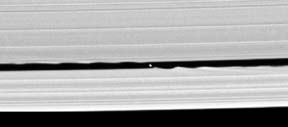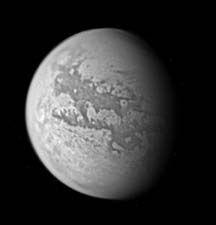Geotimes

Untitled Document

Web Extra
Thursday, May 19, 2005
Saturn's new moon
Within Saturn's infamous rings lies a gap — an opening within the orbiting
particles of ice and rock that compose the planet's rings. It was here that
scientists discovered a previously unknown moon, currently known as S/2005 S1,
in the images sent back to Earth from Cassini less than a year after the spacecraft
began orbiting Saturn.
In a small space between Saturn's rings, known as the Keeler Gap, scientists
have discovered a new moon, currently called S/2005 S1. The new moon is comparable
to the small porous moon Pan, found in the Encke Gap. Image courtesy of NASA/JPL/SSI.
Scientists are aware of about a dozen of these gaps between Saturn's rings,
says Carolyn Porco, head of the Cassini imaging team at the Space Science Institute
(SSI) in Boulder, Colo., and the gaps are formed by either "strong resonances
with external moons or by small moons embedded in the gaps." The "Keeler
Gap," which contains S/2005 S1, is 136,505 kilometers from the gaseous
Saturn.
The researchers had noted strange perturbations and wave motions in the ring
particles near the Keeler Gap. They thus theorized that a moon's gravitational
influences were responsible for making these waves, based on previous observations
of the "Encke Gap," in which another of Saturn's moons, Pan, was found
in 1990 by the Voyager mission. "These peculiar features also had a characteristic
spacing that implied the perturbing moon had to be in the middle of the gap,"
Porco says.
 S/2005
S1 is about 7 kilometers (4 miles) in diameter, but its composition is still
unknown. One way to determine the composition is by spectral observations and
measuring density, says Randolph Kirk, a planetary geologist with the U.S. Geological
Survey, and part of the Cassini Radar team that is currently monitoring Saturn's
moon Titan, the only moon in the solar system known to have an atmosphere. Determining
the density is not an easy task, however, and "generally requires a close
spacecraft flyby to measure the mass," Kirk says. "Such a flyby isn't
possible for a moon within the rings."
S/2005
S1 is about 7 kilometers (4 miles) in diameter, but its composition is still
unknown. One way to determine the composition is by spectral observations and
measuring density, says Randolph Kirk, a planetary geologist with the U.S. Geological
Survey, and part of the Cassini Radar team that is currently monitoring Saturn's
moon Titan, the only moon in the solar system known to have an atmosphere. Determining
the density is not an easy task, however, and "generally requires a close
spacecraft flyby to measure the mass," Kirk says. "Such a flyby isn't
possible for a moon within the rings."
This view of Saturn's moon Titan, the
only moon known to have an atmosphere, was taken during the Cassini spacecraft's
closest flyby of Titan on April 16, 2005. Image courtesy of NASA/JPL/SSI.
Therefore, the team must estimate the mass by examining the size and shape of
the waves created by the interactions between the ring particles and the moon,
Porco says. "But the waves are complicated and so we can't say for sure
how big they are," she says. "If I had to venture a guess, the density
will be like the density of the moons like Atlas and Pan," which are porous
and therefore, not very dense. Determining the density will help the scientists
understand how S/2005 S1 formed and learn about its history.
Scientists have several speculations as to how the moon formed, based on their
limited information about S/2005 S1. It could possibly be a "remnant or
collection of remnants of another larger moon around Saturn that was broken
apart in a catastrophic collision with another object," Porco says, "or
it might be the remnant of a large comet, from the outer solar system, that
came close to Saturn, got torn asunder in the way that Comet Shoemaker-Levy
9 was torn apart, and the material got captured into orbit around Saturn."
The Cassini-Huygens mission was developed to understand the various elements
of Saturn, its rings and moons. In January, the Huygens probe landed on Titan
to measure the atmosphere there and determine if it is a possible analog to
Earth's early atmosphere (see Geotimes
Web Extra, January 2005). In a May 12 press release, scientists from the
NASA Goddard Space Flight Center announced that Titan's atmosphere was 98 percent
nitrogen and the rest methane. Both Cassini and Huygens will perform spectral
mapping for high-quality images of Saturn, its rings and moons.
Those images include more observations of the Keeler Gap with S/2005 S1 and
other gaps during Cassini's orbits, to better understand this new moon and to
see how many more moons are hiding within Saturn's rings. "I predict we
will find more," Porco says.
Laura Stafford
Links:
"Frozen
volcanism on Titan," Geotimes, January 2005
"Huygens
touches down on Titan," Geotimes Web Extra, January 2005
"A
Saturnian one-two punch: Flybys of Titan and Dione," Geotimes
Web Extra, December 2004
"Sliding into
Saturn," Geotimes Web Extra, July 2004
Cassini
Imaging Central Laboratory for Operations (CICLOPS)
NASA
Cassini-Huygens Web site
NASA's
Jet Propulsion Laboratory Cassini-Huygens Web site
Back to top
Untitled Document



 S/2005
S1 is about 7 kilometers (4 miles) in diameter, but its composition is still
unknown. One way to determine the composition is by spectral observations and
measuring density, says Randolph Kirk, a planetary geologist with the U.S. Geological
Survey, and part of the Cassini Radar team that is currently monitoring Saturn's
moon Titan, the only moon in the solar system known to have an atmosphere. Determining
the density is not an easy task, however, and "generally requires a close
spacecraft flyby to measure the mass," Kirk says. "Such a flyby isn't
possible for a moon within the rings."
S/2005
S1 is about 7 kilometers (4 miles) in diameter, but its composition is still
unknown. One way to determine the composition is by spectral observations and
measuring density, says Randolph Kirk, a planetary geologist with the U.S. Geological
Survey, and part of the Cassini Radar team that is currently monitoring Saturn's
moon Titan, the only moon in the solar system known to have an atmosphere. Determining
the density is not an easy task, however, and "generally requires a close
spacecraft flyby to measure the mass," Kirk says. "Such a flyby isn't
possible for a moon within the rings."